2020 Winter — Annual Report
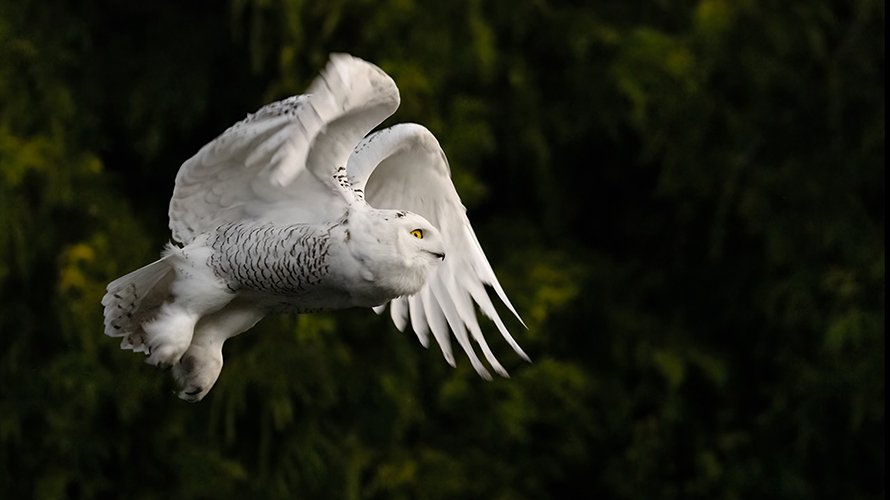
Queen Anne snowy owl, December 2020. (Kyle Rohling, rohlfingwildlife.com)
December 2020
Dear friends,
As we move with hope into a new year, we wish you all peace amid difficulties, connection with others, and the warmth of memories from easier times. A bright spot to close out 2020 is the snowy owl that has visited Seattle neighborhoods for the last few weeks. This temporarily urban raptor, a rare visitor from the Arctic, has delighted hundreds of us with rooftop views.
We at Urban Raptor Conservancy are committed to protecting raptors and documenting our work. Just as importantly, we publicize and share our stewardship about raptors in our dynamic urban environment. We work to inform and welcome observers throughout the region through education and outreach, including our many meetings with you in the field (“Whatcha looking at?”). Before the state’s Covid-19 shutdown on March 16, we squeaked in a local fundraiser at Reuben’s Brewery, and Ed Deal gave talks on the Seattle Cooper’s Hawk Project at Black Hills Audubon in Olympia and Whidbey Audubon. The rest of the year’s social events were canceled, including encores of our popular Hops for Hawks events, the Tukwila Backyard Bird Festival, and public talks—events that connect us with our community.
Seattle Cooper’s Hawk Project
The urban Cooper’s hawk population in Seattle continued its steady growth in 2020. We tallied record numbers of nesting attempts (61), successful nests (51), and fledglings (191)—a tripling of these numbers since 2012. We put ID bands on 43 juveniles and 13 adults (males: purple on left leg, females: orange on right). Read our 2020 Cooper’s Hawk report.
Puget Sound Peregrine Project
Peregrines in Seattle have fared poorly in recent years. Their urban nest choices often conflict with human use (high-rises, bridges including the West Seattle Bridge, Boeing hangars). In 2020, nesting success of Puget Sound peregrines was dismal in Seattle and average in Tacoma (50% juvenile mortality is an average year). Seattle had just three active nests, with only one fledgling possibly still alive. In Tacoma, three nests fledged 11 and seven are now known dead. But there was good news, too. Read our 2020 Peregrine Falcon report.
Raptor Rescues
Every year we get a few calls to rescue a raptor trapped inside a building. Ace trapper Martin Muller responded to two separate incidences of a raptor inside a warehouse. He was able to capture and band the birds, both juvenile male Cooper’s hawks, and release them in safe locations. Patti Loesche and Ed Deal rescued an adult peregrine trapped in a narrow, glassed-in courtyard; it too was uninjured and safely released.
Raptor Banding
We have federal and state permits to put ID bands on the raptors that we study. Each time a banded raptor is sighted again, we learn more about its behavior. How far did it go from its natal territory? Did it find a mate? What is its nesting success? How long do raptors survive in the city?
Sightings of banded birds, especially Seattle’s Cooper’s hawks, skyrocketed this year. We received an astounding 88 band sightings—the previous best year was 48! Your observations are invaluable. Keep it up, citizen scientists!
Training experience. The expertise needed to band raptors requires many months of practice. Opportunities during our field season alone are not enough. The best place to get a lot of experience in a short period is at a field station during fall migration, programs that were canceled in 2020. Fortunately, we have another way to train novice banders, by banding rehabilitated raptors at PAWS Wildlife Center, a program begun in 2017. In 2020, using Covid-19 protocols, we’ve banded 70 owls, accipiters, hawks, and eagles. A small new team has now begun training at the “PAWS Banding Academy.” We are indebted to PAWS for this partnership.
We are learning more about rehabbed raptors. While banders gain experience at PAWS, banding raptors allows PAWS to track them once they return to the wild. Thanks to banding, we learned that a rehabbed Cooper’s hawk released early this year found a mate and nested soon afterward. Even band sightings on dead birds tell us stories about raptors that we could not otherwise know.
We have long banded Cooper’s hawks and peregrine falcons with colored visual identification (VID) leg bands as part of our monitoring studies. This year URC also began banding rehabilitated bald eagles prior to release—15 to date. Larry Hubbell, Martin Muller, and Ed Deal funded the bands. That eagle bling costs $20 apiece!
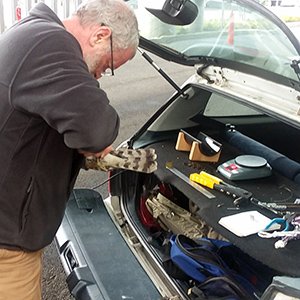
Martin Muller bands wayward juvenile Cooper’s hawk rescued from a warehouse. (URC)

Visual ID bands help URC to track individual Cooper’s hawks. Purple band on left leg: males; orange band on right: females. (Peg Morgan)
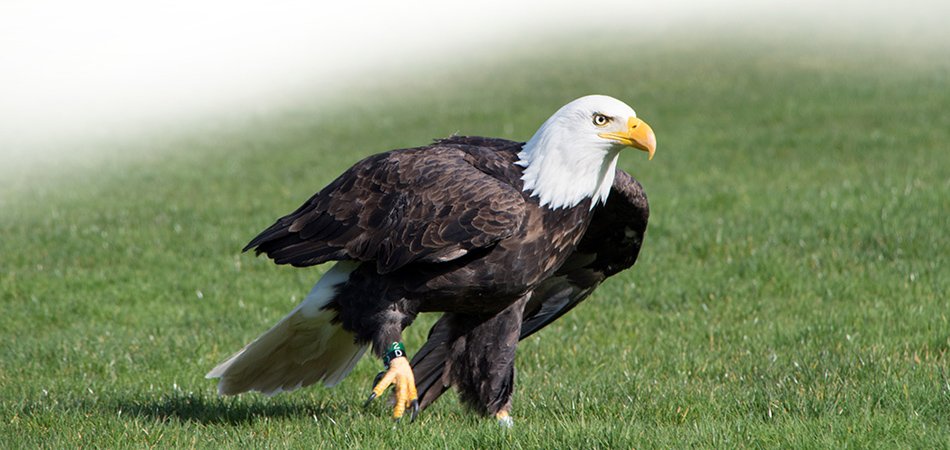
Adult bald eagle 2-D gets a second chance from PAWS. (PAWS Wildlife Center)
RODENTICIDES IN RAPTORS PROJECT
We will soon complete testing for blood-thinning rat poisons (anticoagulant rodenticides, ARs) in Washington raptors that have died at PAWS. This costly, time-intensive study would be impossible without both the generous support of donors and logistical expertise by PAWS staff.
We have tested five owl species (barred owl, great horned owl, barn owl, Western screech-owl, Northern saw-whet owl) and four species of diurnal raptors (red-tailed hawk, sharp-shinned hawk, Cooper’s hawk, northern goshawk). Over 90% of the birds studied so far are positive for ARs. Our results will highlight the prevalence of these highly toxic rodenticides in non-target wildlife in Washington.
• Rat poison bait boxes are all over the city, in every residential and commercial neighborhood and many green spaces, including our parks.
• In September, Governor Gavin Newsom signed the 2020 California Ecosystems Protection Act (AB 1788) into law, placing greater restrictions on the use of second-generation anticoagulant rodenticides to protect the state’s native wildlife.
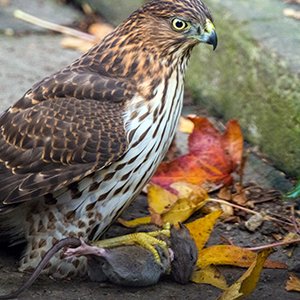
Cooper’s hawk in Ballard with rat prey. (Shawn Crowley)
What’s ahead for URC in 2021?
We will:
1. Complete the Rodenticides in Raptors study: finish data collection and analyze and publish results.
2. Continue to monitor the status of the region’s urban raptors
- We will continue to build relationships and work closely with private and commercial stakeholders and state and federal agencies to minimize human-peregrine conflicts.
- Cooper’s hawks nest throughout Seattle’s 83 square miles and are our greatest urban ambassadors. They are easy to point out during the breeding season in parks, back yards, and even downtown.
- Merlins are often more elusive, but these forest falcons too capture widespread interest. Urban Cooper’s hawks and merlins seem to be thriving in our region. Read about the Seattle Merlin Project here.
3. Continue to band and track rehabilitated raptors.
4. Increase public awareness of bird window strikes and how to prevent them.
- As the breeding season ends, the window-hit season begins. A rare story of survival from a window strike is Hope, a peregrine hatched in downtown Tacoma in 2017. Soon after fledging she hit a window and was injured too badly to be rewilded. Now she lives at the High Desert Museum in Bend, Oregon.
5. Continue outreach: recruit and train volunteers, broaden our outreach to more diverse populations, talk about our work, conduct field trips, and solicit public sightings of urban raptors.
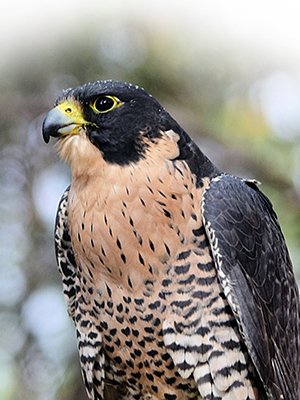
Window strike survivor Hope, a three-year-old Peregrine falcon (Miahna Corella)
At this writing, the 1201 Third Avenue falcon cam has revealed a pair of peregrine falcons at the flagship nest site in downtown Seattle—for the first time since December 2019. We will never know why peregrines skipped nesting there in 2020, but along with this promise of a new beginning, we send our warmest wishes for a happy new year.
Urban Raptor Conservancy
info@urbanraptorconservancy.org
https://urbanraptorconservancy.org